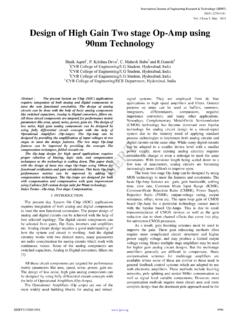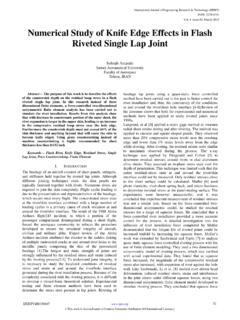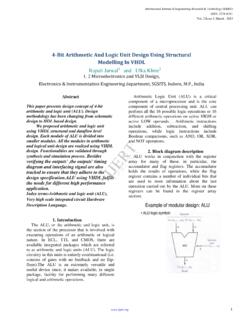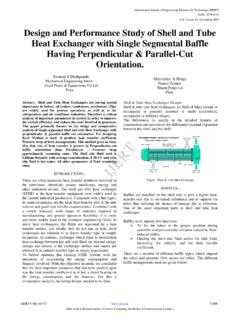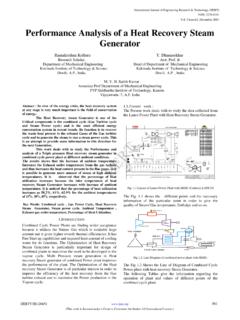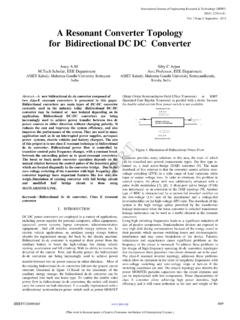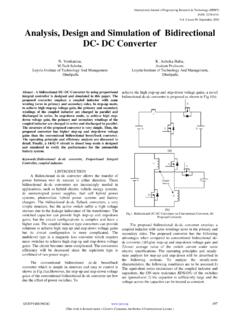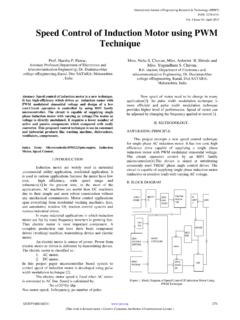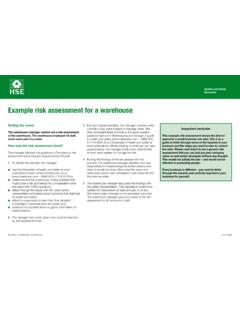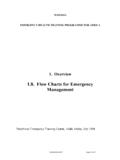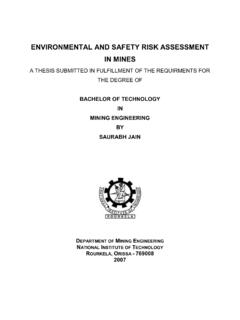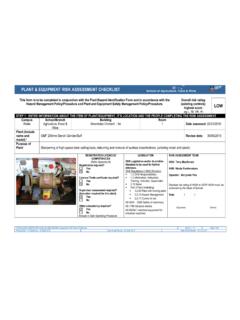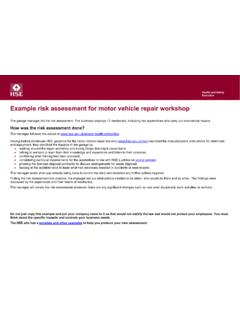Transcription of Hazards Identification and Risk Assessment in Thermal ...
1 Hazards Identification and Risk Assessment in Thermal Power Plant Ruchi Shrivastava, (Indu. Safety Engg.) Dept. of fire technology and Safety Engg., IES-IPS Academy, Indore ( ), India Praveen Patel, Assistant professor Dept. of fire technology and Safety Engg., IES-IPS Academy, Indore ( ), India Abstract The Thermal power plant is a large electricity generation industry. It consist a number of process by mean to generate electricity by use of fossil fuel. It also consist several major equipment and operations involve in its process. The purpose of hazard Identification and risk Assessment in Thermal power plant is to identify physical, chemical, biological and environmental Hazards in the plant, analyse the event sequences leading to those Hazards and calculate the frequency and consequences of hazardous events.
2 Then risk level is assigned to each hazard for identifying required corrective action to minimize the risk or eliminate the Hazard. Keywords Thermal power plant; Risk Assessment ; Hazard Identification ;risk matrix. I. INTRODUCTION In present scenario for any industry to be successful it should meet not only the production requirements but also maintain the safety standards for all concerned. The coal fired Thermal power plant susceptible to a wide range of Hazards in its various operational areas. Hazard Identification and risk Assessment is systematic approach to protect the health and minimize danger to life, property and environment.
3 This paper highlights report on HIRA applied in the Thermal power plant, Korba EAST ( ). It includes the methodological steps to identify hazard related to materials, operations and conditions. Assess the risk level of the Hazards and apply or suggest the possible remedies and corrective actions to reduce the risk. II. METHODOLOGY Hazard Identification and risk Assessment is a combinations deterministic, probabilistic and quantitative method. The deterministic methods take into consideration the products, the equipment and the quantification of the various targets such as people, environment and equipment.
4 The probabilistic methods are based on the probability or frequency of hazardous situation apparitions or on the occurrence of potential accident. The quantitative methods analyses various data numerically. The five steps of hazard Identification and risk Assessment are: Step1: System Description: Define the system and there subsystem and operations. Step2: Hazard Identification - Defining and describing a hazard, including its physical characteristics, magnitude and severity, causative factors, and locations or areas affected. Step3: Risk Analysis- Analyze the Probability, frequency or likelihood the potential losses associated with a hazard.
5 Step4: Risk Rating - Risk Classification Screening Table is formed and value of hazard or calculated risk class gives the require action to be taken. Step5: Resolve the Risk corrective action recommended preventing, reducing or transferring the risks , by short and long term planning. III. PLANT DISCRIPTION Thermal power plant is electricity generation plant which converts the fossil fuel stored energy to electrical energy by means of generating electricity. In other words, it is merely a chain of Energy conversion as follow: Chemical energy in the fuel is converted to Heat energy of steam.
6 Heat energy of steam is converted to Mechanical or rotating energy of a rotating wheel called Turbine. The mechanical energy of Turbine is converted as Electrical Energy in a Generator. As shown in the the Thermal power plant has the following area operations: A. Coal Handling Plant Coal transported to the plant by the rail line and carrier trucks. This coal is transfer from the underground bunker to crusher by series of conveyer belt. In coal crusher coal size reduced up to after that coal transfer to the boiler s coal bunker or coal yard. In the case of emergency the coal is fetch from coal yard.
7 Coal feeder control the quantity of coal from coal bunker and send it to the ball mill or roll mill for pulverization process. Where coal crushed to the fine powder and mixed with preheated air come through the air from pre-heater. This process use for drying the coal and sends coal powder up to the burner of furnace. The rest of impure coal and rocks pass out to the bottom of mill and transfer to the clinker grinder then to the storage. B. Plant Raw water is de-mineralizing to free water from salts and ions then treated with sulphuric acid and caustic soda to retain the ph level up to 9.
8 This process is done in the demineralization plant. De-mineralized water transfers through pipeline to D. M. water tank. 463 Vol. 3 Issue 4, April - 2014 International Journal of Engineering Research & Technology (IJERT) ISSN: Figure 1: Thermal power plant layout C. Boiler The Feed water pump pass the water through low pressure heater, high pressure heater and economizer to raise its temperature and send to boiler drum. The furnace of the boiler had four coal burner and one diesel burner. Diesel burner used to rises the temperature of furnace up to up to auto ignition temperature of pulverized coal.
9 Coal burn and generate flue gases which boil the water of boiler drum. Then flue gases passes through super heater , secondary super heater, re-heater, economizer, air pre-heater and tri-sector air heater after that its temperature is reduced. The flue gas mainly content fly ash particles and air pollutants like SOx , NOx, COx, toxic gases, metal fumes so before passing it to the chimney its treated in the Electro-static precipitator. In the fly ash particles and pollutants are extracted from the flue gases by using ammonia. D. Turbine and Generator The generated steam is passing through the super heater to the high pressure turbine.
10 After driving the turbine a part of this steam sends to the heater 2 and left pass through the re-heater then secondary super heater and regain its pressure to drive Intermediate turbine. Then the steam transfer to the 2 and low pressure turbine. Then steam from low pressure turbine transfer to 4-5-6 and condenser. In condenser steam is cooled by cooling water and then deaerator circulates it for steam generation. The three turbines used to drive one shaft which drives the rotor of the generator by mean to generate electricity. The various auxiliaries of turbine and generator is cooled by hydrogen gas and cooling oil.

